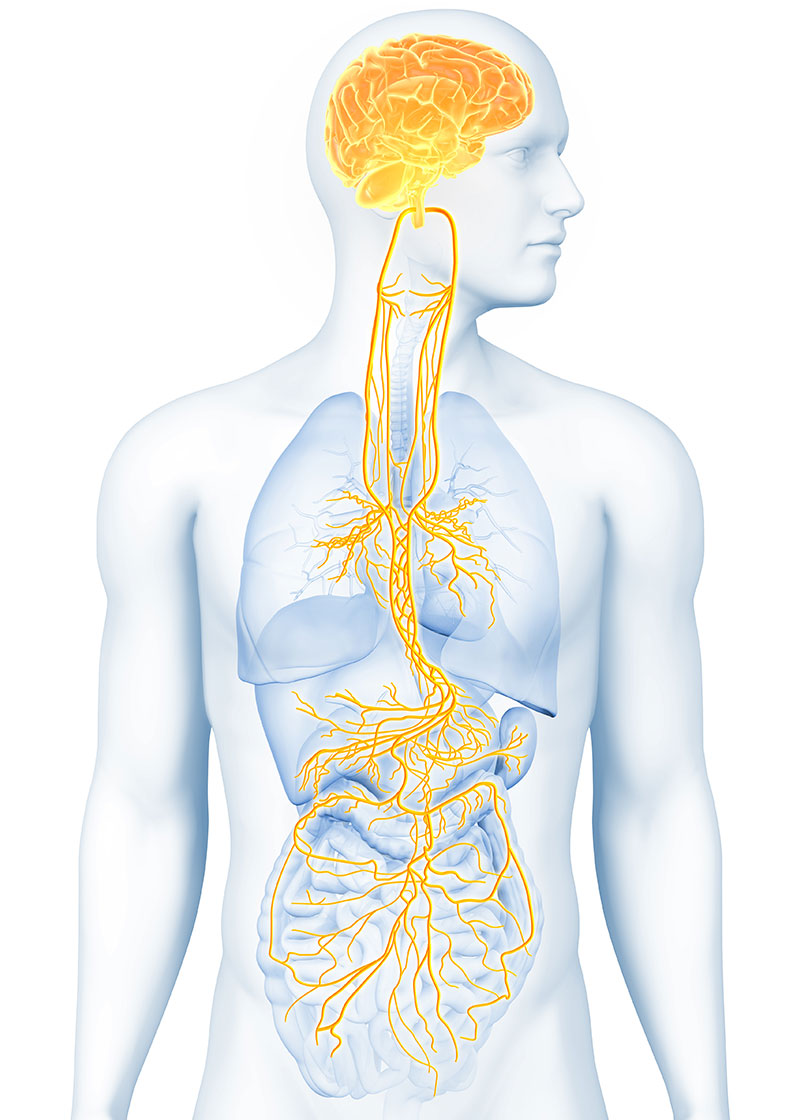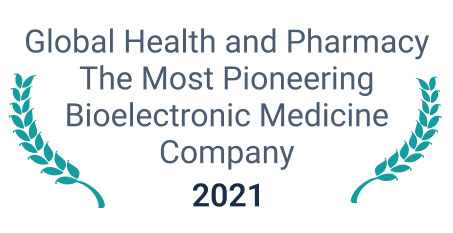About Us

Tivic Health. We are an immunotherapeutics company.
Our science focuses on restoring the healthy function of the immune system. Whether it is through our TLR5 biologics programs, which are shown to have therapeutic and preventative applications, or via our non-invasive cervical vagus nerve stimulation (ncVNS) device, which is being studied to treat several very large patient populations, Tivic Health is working to improve the medical treatment landscape by restoring immune health.

Vagus Nerve Stimulation: Tivic Health’s Next-Generation Treatment Paradigm
At Tivic Health we are working to treat some of today’s most prevalent inflammatory and neurological diseases through bioelectronic medicine, specifically, the stimulation of the body’s vagus nerve — the command-and-control center of the body.
The Function and Benefits of Stimulating the Vagus Nerve
The vagus nerve is one of the most critical nerves in the body, connecting the brain to many vital organs, including the heart, lungs, and digestive tract. The word “vagus” means wandering in Latin, which is appropriate as it is the longest of the cranial nerves. Although it is often referred to as singular, it’s actually a pair of nerves that emerge from the right and left side of the brainstem and carry signals from the brain to the rest of the body and vice versa using both afferent sensory fibers relaying information to the brain and efferent nerves relaying information to the organ.
The vagus nerve is responsible for balancing many of the body’s essential functions, including digestion, breathing, and heart rate. It also plays a crucial role in controlling the parasympathetic nervous system, which is responsible for calming the body and reducing stress levels. The nerve helps to regulate the release of hormones and cytokines, which are involved in the body’s immune response. It also helps to regulate inflammation and can modulate the release of neurotransmitters such as dopamine and serotonin, which are involved in mood regulation.
The afferent section is responsible for carrying sensory information from the peripheral organs and tissues to the central nervous system. This section of the nerve contains specialized nerve fibers that detect and transmit information about various physiological parameters, including blood pressure, heart rate, respiration, and digestion.
Benefits of Stimulating the Vagus Nerve
Vagus nerve stimulation (VNS) is a therapeutic approach that involves the use of electrical impulses delivered to the vagus nerve to treat a variety of medical conditions. VNS can be achieved through both invasive and non-invasive stimulation.
Invasive VNS:
Invasive VNS involves the surgical implantation of a device that delivers electrical impulses to the vagus nerve. The device is typically implanted in the chest and is connected to the nerve via a wire that runs under the skin. Invasive VNS has been approved by the FDA for the treatment of several medical conditions. Examples of some of the applications of invasive VNS include:
Epilepsy (FDA approved):
Invasive VNS has been shown to be effective in reducing the number of seizures in patients with drug resistant epilepsy.1 The delivery of electrical impulses to the vagus nerve is thought to reduce the frequency and intensity of seizures by modulating the activity of the brain.
Depression (FDA approved):
Invasive VNS can be effective in improving the symptoms of treatment-resistant depression.2 A device is implanted and sends electrical impulses to the vagus nerve, which is believed to increase the activity of the neurotransmitter serotonin, a chemical that plays a role in regulating mood.
Arthritis (research ongoing):
There are many different types of arthritis, which is a chronic condition that is characterized by inflammation and pain in the joints. The two most common types are rheumatoid arthritis (RA) and osteoarthritis (OA). Studies have shown that VNS can reduce inflammation and pain in the joints, and increase the production of regulatory T cells, which can help to control the immune response and prevent inflammation.3
Non-invasive VNS:
Non-invasive VNS involves the use of external devices to stimulate the vagus nerve, without the need for surgical implantation. Non-invasive VNS typically delivers electrical signals that penetrate the skin and underlying soft tissues to reach the vagus nerve directly and has been proven to safely and effectively stimulate the vagus nerve for the following representative applications.
Migraines (FDA Cleared):
Non-invasive VNS is an effective treatment for migraines. Stimulation involves placing electrodes on the skin over the vagus nerve in the neck and delivering electrical impulses to the nerve. Several studies have shown that it can be effective in reducing the frequency and severity of migraines in some patients.4
Chronic Pain (studies ongoing):
Non-invasive VNS has been used to treat chronic pain conditions including fibromyalgia and neuropathic pain. Stimulation involves placing electrodes on the skin over the affected area and delivering electrical impulses to the nerves. Studies have shown that VNS can be effective in reducing pain and improving quality of life in some patients with chronic pain.5
Anxiety Disorders (studies ongoing):
Non-invasive VNS has been studied as a potential treatment for anxiety disorders, such as generalized anxiety disorder and panic disorder. Several studies have shown that VNS can be effective in reducing symptoms of anxiety in some patients.6
Heart Failure (studies ongoing):
Non-invasive VNS has been studied as a potential treatment for heart failure, a condition in which the heart is unable to pump enough blood to meet the body’s needs. VNS was found to be effective in reducing blood pressure in patients with hypertension. Patients received noninvasive VNS therapy, which involved the use of a device that delivered electrical impulses to the ear. The researchers found that VNS led to a significant reduction in both systolic and diastolic blood pressure.7
Conclusion
VNS is a promising therapeutic approach for several medical conditions. Future possibilities include not only non-invasive VNS but also targeted VNS, VNS for neurodegenerative diseases, autoimmune diseases, mental health, obesity, and diabetes. With further research and development, VNS has the potential to not only revolutionize the treatment of many conditions but also to improve the lives of millions of people.
While the exact mechanism of action is not completely understood, it is believed that VNS has the ability to modulate the activity of the nervous system, leading to improvements in symptoms. It is important to note that VNS is not suitable for everyone, and appropriate discussion is recommended of alternate potential therapies with a healthcare provider based upon individual needs and circumstances.
- Toffa, D. H., Touma, L., El Meskine, T., Bouthillier, A., & Nguyen, D. K. (2020). Learnings from 30 years of reported efficacy and safety of vagus nerve stimulation (VNS) for epilepsy treatment: a critical review. Seizure, 83, 104-123.
- Cristancho, P., Cristancho, M. A., Baltuch, G. H., Thase, M. E., & John, P. O. (2011). Effectiveness and safety of vagus nerve stimulation for severe treatment-resistant major depression in clinical practice after FDA approval: outcomes at 1 year. The Journal of clinical psychiatry, 72(10), 5594.
- Genovese, M. C., Gaylis, N. B., Sikes, D., Kivitz, A., Horowitz, D. L., Peterfy, C., … & Chernoff, D. (2020). Safety and efficacy of neurostimulation with a miniaturised vagus nerve stimulation device in patients with multidrugrefractory rheumatoid arthritis: a two-stage multicentre, randomised pilot study. The lancet rheumatology, 2(9), e527-e538.
- Vukovic Cvetkovic, V., & Jensen, R. H. (2019). Neurostimulation for the treatment of chronic migraine and cluster headache. Acta Neurologica Scandinavica, 139(1), 4-17.
- Molero-Chamizo, A., Nitsche, M. A., Bolz, A., Andújar Barroso, R. T., Alameda Bailén, J. R., García Palomeque, J.
C., & Rivera-Urbina, G. N. (2022). Non-invasive transcutaneous vagus nerve stimulation for the treatment of fibromyalgia symptoms: a study protocol. Brain Sciences, 12(1), 95. - Grolaux, P. J. (2019). Transcutaneous vagus nerve stimulation in private healthcare center: a small-scale
investigation targeting anxiety, irritable bowel syndrome and chronic pain. Journal of Neurology & Neuromedicine, 4(5). - Jiang, Y., Po, S. S., Amil, F., & Dasari, T. W. (2020). Non-invasive low-level tragus stimulation in cardiovascular diseases. Arrhythmia & Electrophysiology Review, 9(1), 40.
Awards & Recognition
Tivic Health and ClearUP have earned accolades and awards from around the globe.



